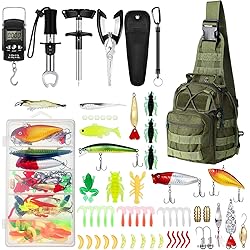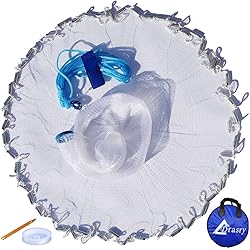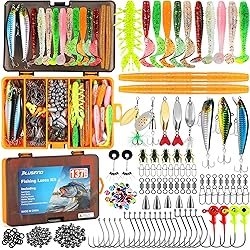Why Lakes Are Dangerous? Lakes can be very dangerous for anyone who spends time in or around them, no matter how serene and quiet they appear to be.
Taking the necessary precautions and being aware of potential risks are essential for staying safe in this open ocean.
Key Takeaways:
- Lakes may have hidden hazards that are not immediately apparent.
- Currents and tides can pose risks to swimmers, boaters, and other water enthusiasts.
- Proper safety equipment, awareness, and emergency preparedness are essential for staying safe on and near lakes.
- Children are particularly vulnerable to the dangers of lakes, and extra precautions must be taken to keep them safe.
- Boaters must be especially careful on lakes due to unique dangers associated with these bodies of water.
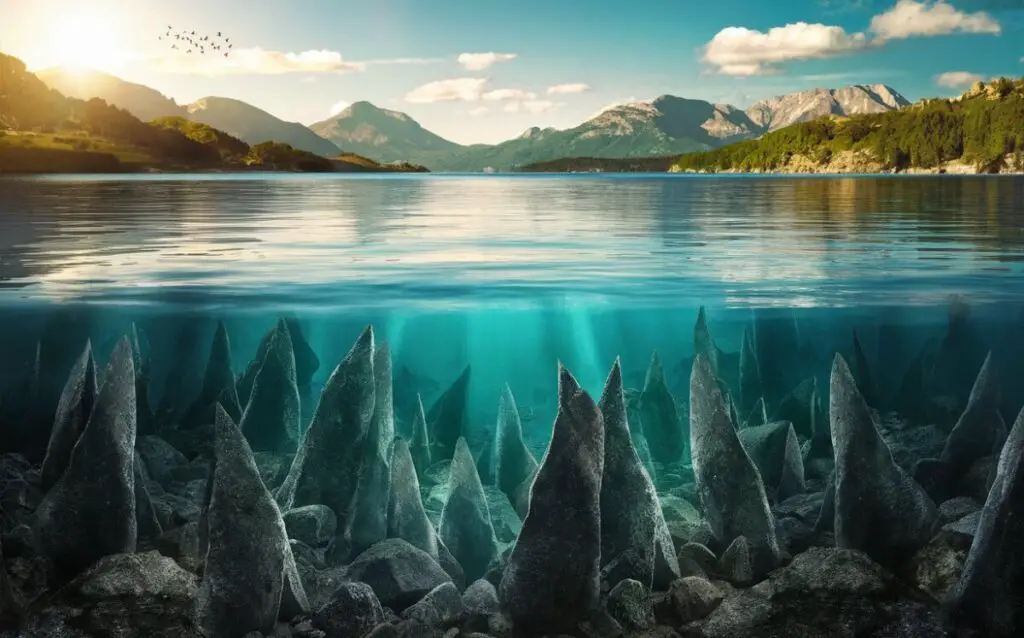
Hidden Hazards in Serene Settings
Despite their beauty and friendliness, lakes hide dangers beneath their serene surfaces.
Everyone who enjoys lakes must be aware of the risks and take precautions.
Here are some guidelines for lake safety and water safety measures to keep in mind:
Swimming in lakes can be risky.
While swimming in a lake might be a lot of fun, there are a number of hazards involved.
The biggest risk is drowning, which can happen at any time and to anyone, regardless of swimming ability. The following are additional risks:
- Strong currents
- Sudden drop-offs
- Underwater obstacles such as logs, rocks, or vegetation
- Poor water quality, which can cause illness or infection
It’s essential to be mindful of these hazards and take appropriate precautions while swimming in a lake.
Lake Water Hazards
Lake water hazards can be difficult to spot, and they may pose a danger to swimmers, boaters, or anyone else enjoying the lake. Here are some common hazards to watch for:
| Hazard | Description |
|---|---|
| Strong currents | Can push swimmers off course or make it difficult to swim |
| Sudden drop-offs | Steep changes in underwater depth that can catch swimmers off guard |
| Underwater obstacles | Logs, rocks, vegetation, and other debris that can pose a risk to swimmers or boaters |
| Poor water quality | Bacteria, algae, and other contaminants that can cause illness or infection |
Being aware of these hazards can help you spot potential dangers and avoid them while enjoying a lake’s recreational activities.
Lake Safety Tips
Here are some practical lake safety tips to ensure you stay safe while enjoying your time near or in a lake:
- Always swim in designated areas and follow posted rules and regulations
- Swim with a buddy or within sight of a lifeguard
- Wear a life jacket when boating or participating in water sports
- Never swim under the influence of drugs or alcohol
- Take swimming lessons to improve your skills and confidence
- Learn CPR and basic water rescue techniques
By following these lake safety tips and water safety precautions, you can enjoy your time at the lake while minimizing risks.
you may also like this: Explore the Thrills of the Most Dangerous Aquarium

Understanding Lake Currents and Tides
Although lakes may appear placid and tranquil, there are hazards associated with them. The existence of currents and tides is one of the major risks associated with lakes.
To ensure that recreational activities in and around lakes are safe, it is essential to understand lake currents.
Lake Current Influencing Factors
A number of variables, such as wind, temperature, and topographical characteristics, combine to generate lake currents.
The wind causes the water to move, and this movement has the potential to produce currents.
When it comes to lakes, the effect of wind is more noticeable in the shallower areas of the body of water, pushing the water about and generating currents.
Variations in the water’s temperature can also cause currents. For instance, when the sun heats the surface water, it becomes less dense and rises to the top, creating currents.
The lake’s underlying terrain may also be impacted by its currents.
Undersea ridges, islands, and other objects can alter the current’s direction and speed. Tides can also affect the currents in lakes.
Lake Current Hazards
Lake currents may put swimmers, boaters, and other water sports enthusiasts in serious danger.
Strong currents may sweep a person away and fatigue them, making it difficult for them to swim back to safety.
Additionally, currents can be problematic for boats, making navigation challenging, particularly for new boaters.
Staying Safe in Lake Currents
If you want to enjoy lakeside recreation activities safely, it’s essential to understand lake currents. Always check the weather prediction before heading to the lake.
Strong currents caused by windy weather can make it unsafe for boaters and swimmers to stay afloat.
It’s also critical to pay attention to the warnings about the strong currents surrounding the lake.
Avoid swimming by yourself and stick to the approved zones. Avoid resisting a stream that catches you.
Instead, to gradually break free from the current’s grip, swim parallel to the beach. When boating, ensure that your vessel has all the required safety gear, such as personal flotation devices.

Staying Safe: Lake Safety Equipment and Awareness
The most important thing to consider while spending time in or around lakes is safety. The key to preventing mishaps and injuries is being aware of potential dangers and realizing the value of appropriate safety gear.
Safety Gear for Lakes
A life jacket is among the most important items of safety gear when around or in lakes.
Wearing a life jacket that fits properly is essential, whether sailing, swimming, or engaging in any other water sport.
Other floating devices, such as inner tubes or pool noodles, can offer additional support and protection in addition to life jackets.
A safety buoy is yet another essential piece of gear for lake safety. You can use these buoys as emergency signals, identify swimming areas, or warn people about potential underwater risks.
you may also like this:Is Pool Algae Harmful to Humans? Unveiling the Green Mystery
Lake Warning Signs
Many lakes have warning signs posted to alert visitors of potential hazards.
These signs may indicate areas with strong currents, underwater obstacles, or poor water quality.
It is important to pay attention to these signs and follow their instructions to ensure safety while on the lake.
Water Safety Awareness
Being aware of potential hazards and following proper safety guidelines is crucial for water safety.
The following tips can help increase awareness and ensure a safe and enjoyable lake experience:
- Swim in designated areas
- Never swim alone
- Use the buddy system
- Be aware of personal swimming abilities
- Avoid diving in shallow water
- Never swim under the influence of drugs or alcohol
Lake Safety Guidelines
Each lake may have specific safety guidelines that visitors should be aware of. These guidelines may include rules for boating, fishing, and other water activities.
It is important to familiarize oneself with these guidelines and to follow them to ensure a safe and enjoyable experience.
Lake Danger Awareness
Understanding the potential dangers of lakes is crucial to preventing accidents and injuries. Some common lake hazards include:
- Strong currents
- Sudden drop-offs
- Underwater obstacles
- Poor water quality
Being aware of these hazards and following proper safety guidelines can help prevent accidents and ensure a safe and enjoyable lake experience.
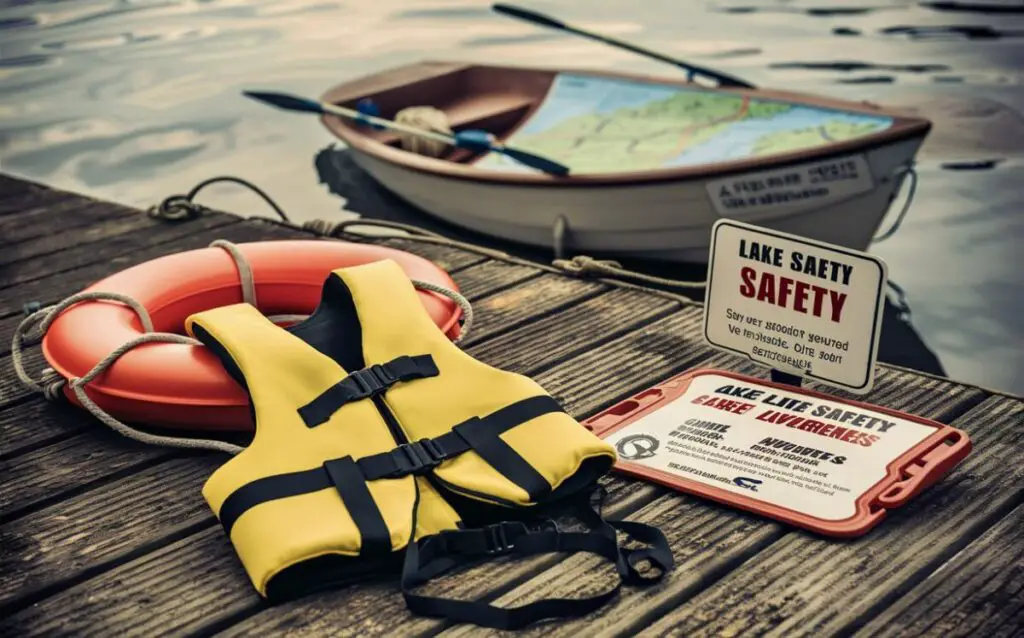
Preventing Accidents: Lake Emergency Preparedness
It’s important to be ready for emergencies, even if spending a day at the lake with loved ones may be a lot of fun.
Those who may find themselves in a dangerous situation run a serious risk when they are far from medical facilities and necessary equipment.
Emergency preparedness at Lake Tahoe is critical for avoiding mishaps and making the right decisions in an emergency.
People who enjoy lakeside recreation may take extra precautions to prepare themselves and their families for emergencies.
Being able to respond to regular lake accidents and acquire basic water rescue skills are important components of disaster preparation.
Techniques for water rescue
Knowing how to react promptly and responsibly when someone is having trouble in the water can make all the difference.
The following are some crucial water rescue methods that can keep people safe and perhaps save lives:
You might also enjoy this: Explore the Most Perilous Aquarium Exhilaration
Why Lakes Are Dangerous
| Technique | Description |
|---|---|
| Reach | Extend a long object, such as a branch or paddle, to the person in distress and pull them to safety. |
| Throw | If the person is too far away to reach, throw a floating object, such as a life buoy or rope, for them to hold onto and pull them to safety. |
| Row | If a boat is available, row it to the person in distress and pull them aboard. |
| Swim | If no equipment is available, swim to the person in distress and pull them to safety. Ensure to avoid putting yourself at risk while attempting this technique. |
Preventing Lake Accidents
While knowing how to respond in emergencies is essential, preventing accidents from occurring in the first place should always be a priority.
Below are some crucial lake safety precautions that individuals can take to help prevent accidents:
- Swim in designated areas only and follow all posted rules and regulations.
- Use a buddy system, especially if swimming in deep or unfamiliar waters.
- Avoid alcohol consumption before or during water activities as it can impair judgment and coordination.
- Ensure to wear appropriate safety equipment, such as life jackets or flotation devices.
- Learn to recognize warning signs of possible danger in the water, such as changes in water color or temperature.
By being prepared and taking the necessary precautions, individuals can help prevent accidents and respond appropriately in an emergency.
Stay safe and enjoy spending time in and around the beautiful lakes our world has to offer.
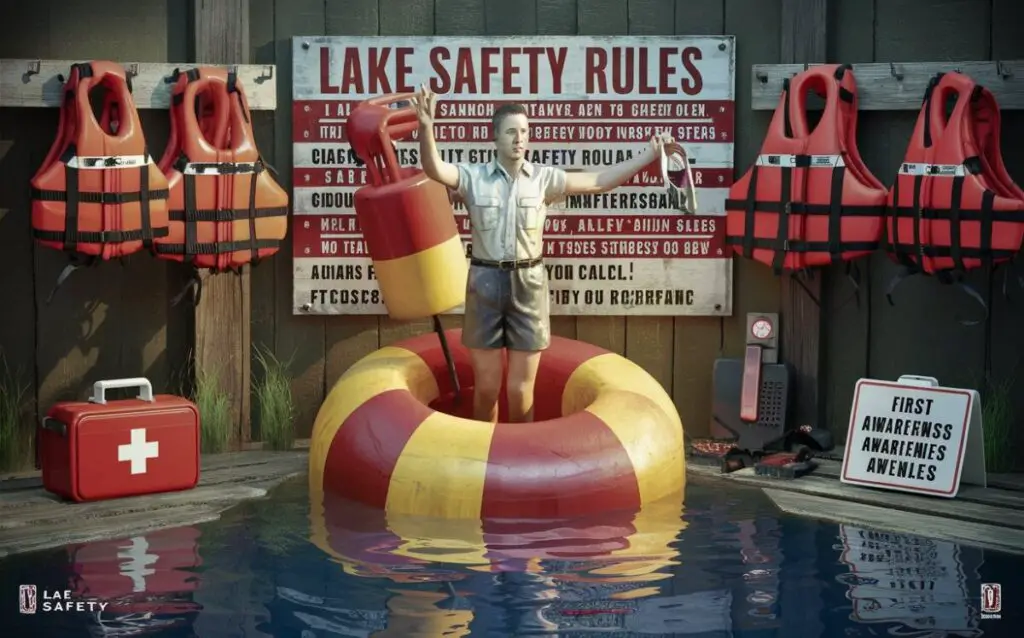
Risks for Children: Lake Dangers and Safety Measures
When it comes to lakes, children face unique risks that require specific safety measures.
Parents must be aware of these risks and take the necessary precautions to prevent accidents from happening.
Lake Dangers for Children
Children who swim in lakes are exposed to multiple water hazards that can lead to injury or drowning. Some of the most common hazards include:
| Water Hazards | Associated Risks |
|---|---|
| Sudden drop-offs | Child may not be able to swim back to safety |
| Poor water quality | Child may become ill or contract waterborne diseases |
| Underwater obstacles | Child may collide with or become trapped in underwater debris |
Additionally, children may overestimate their swimming abilities or underestimate the strength of lake currents, leading to exhaustion or injury.
Swimming Safety
To prevent accidents and injuries in lakes, it’s important to follow these swimming safety tips:
- Teach children to swim at an early age.
- Always supervise children around lakes.
- Swim in designated areas with lifeguards.
- Use the buddy system and swim with a partner.
- Encourage children to wear proper flotation devices.
- Never leave children unattended near lakes.
By following these safety measures, parents can help ensure that their children stay safe while enjoying lakes.
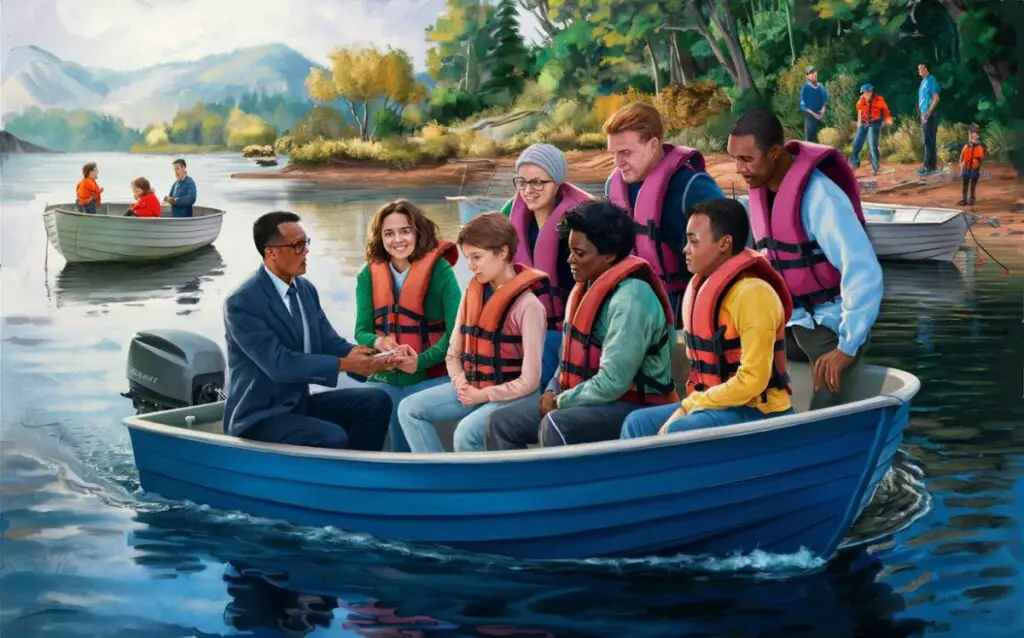
Navigating Boating Safety on Lakes
Boating can be a fun and exciting way to enjoy lakes, but it also comes with inherent risks.
It’s important to understand the potential dangers of boating on lakes and take necessary safety precautions to prevent accidents.
Dangers of Boating in Lakes
Compared to other bodies of water, lakes can present unique dangers for boaters.
Lakes often have unpredictable weather conditions that can change rapidly, creating hazardous boating conditions.
Additionally, lakes may have underwater obstacles such as rocks, logs, and other debris that may not be visible from the surface.
These obstacles can cause serious damage to boats and injuries to passengers.
Boating Safety Tips
To stay safe while boating on lakes, it’s important to follow these safety tips:
- Always wear a properly fitting life jacket or personal flotation device (PFD) while on the boat.
- Check the weather forecast before heading out and avoid boating in inclement weather.
- Avoid alcohol consumption while boating. Alcohol slows reaction time and impairs judgment, increasing the risk of accidents.
- Inspect the boat before departing and ensure that all equipment is in good working condition.
- Be aware of the underwater terrain and avoid areas with known hazards.
- Follow all boating regulations and adhere to posted speed limits and other restrictions.
- Designate someone as the “spotter” to keep an eye out for other boats, swimmers, and obstacles in the water.
- Bring a fully charged cell phone or radio to call for help in an emergency.
Dangers of Boating on Lakes
Accidents involving boats can be fatal or extremely dangerous. The U.S. Coast Guard reports that there were 4,168 boating incidents in 2019, with 2,559 injuries and 613 fatalities.
Prioritizing boat safety and having an emergency plan in place are critical.
It’s critical to have an emergency plan in place in addition to adhering to boating safety guidelines.
This can entail becoming proficient in fundamental water rescue skills and being aware of how to handle typical lake mishaps like capsizing or collisions.
By may enjoy the thrill and excitement of boating on lakes while lowering the hazards by adhering to these boating safety recommendations and being ready for emergencies.

Hazards Below the Surface: Underwater Terrain and Hypothermia
Although lakes’ placid exteriors can seem innocuous, there are hidden dangers that can seriously endanger boaters and swimmers.
If people come into contact with underwater terrain—which includes rocks, tree branches, and other obstacles—they might suffer serious injury.
Safeguarding against these risks requires awareness and precaution.
Spending time in cold-water lakes increases one’s risk of hypothermia in addition to exposure to underwater terrain.
When the body temperature falls below normal, hypothermia sets in, causing symptoms including shivering, disorientation, and even unconsciousness. Hypothermia can be lethal in extreme circumstances.
You might also enjoy this: Explore the Most Perilous Aquarium Exhilaration
Steer clear of underwater hazards.
People should be careful to avoid unmarked swimming places and stick to approved swimming zones to lower their risk of damage from aquatic dangers.
Boaters should use caution and steer clear of any places that could include underwater obstructions.
Using protective gear, such as sandals or water shoes, can also help prevent injuries from underwater risks.
It is also advised to never go boating or swimming alone, and to always have a buddy system in place.
Preventing Hypothermia
Taking the right steps can help avoid hypothermia, which is a dangerous condition.
When spending time in cold-water lakes, it’s vital to wear suitable clothes, such as a drysuit or wetsuit, to remain warm.
Furthermore, limit the amount of time you spend in cold water and take breaks to rewarm as needed.
Additionally, boaters need to make sure they have the right gear, including life jackets, in case of an emergency that might result in hypothermia.
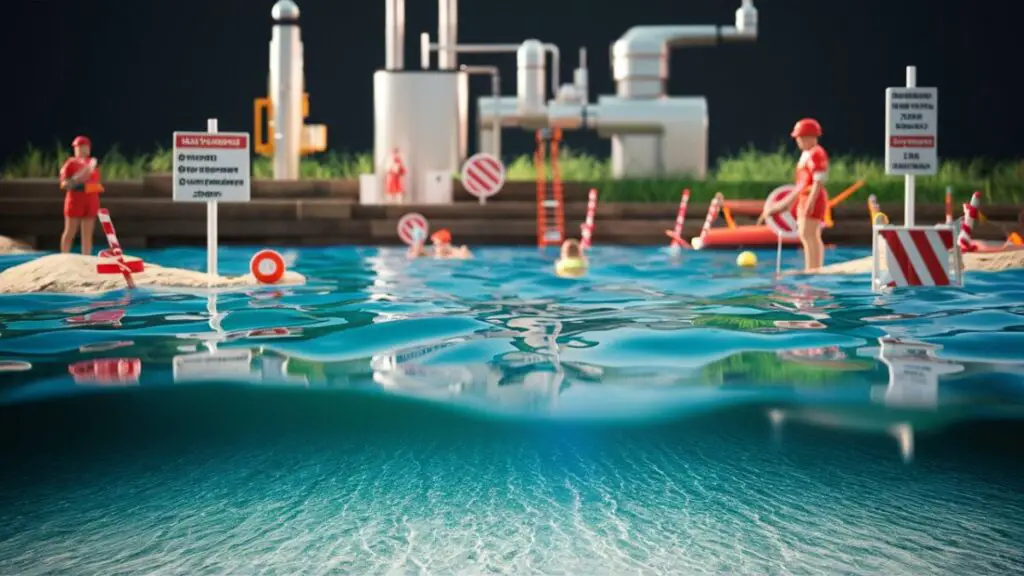
Water Quality and Recreation Safety
When enjoying recreational activities in lakes, water quality is an important factor to take into account.
Health concerns associated with low water quality include infections, skin irritation, and chemical ingestion.
Prior to entering the lake for leisure, it is crucial to be aware of its water quality.
Numerous variables, such as pollution, runoff from urban and agricultural regions, and natural occurrences like floods or algal blooms, can have an impact on a lake’s water quality.
The Environmental Protection Agency (EPA) monitors the condition of the country’s lakes and other water bodies. On their website, they also publish data on the water quality of various lakes across the country.
People can also protect themselves by taking personal safety measures near potentially polluted water.
This includes cleaning your hands completely after swimming, avoiding ingesting water, and avoiding swimming in locations where pollution is clearly apparent (such as oil slicks or trash).
Swimmers who go swimming for fun should also be aware of the signs and symptoms of recreational water ailments, such as skin rashes, diarrhea, and cramping in the stomach.
An individual should get medical help right away if they encounter any of these symptoms following a lake swim.
Water Recreation Safety Guidelines
- Always check the water quality of a lake before engaging in recreational activities.
- Avoid swimming in areas with visible signs of pollution or algae blooms.
- Wash thoroughly after swimming.
- Avoid swallowing lake water.
- Be aware of the symptoms of recreational water illnesses.
- Seek medical attention if experiencing symptoms.
By following these water recreation safety guidelines, individuals can enjoy their time near and in lakes while minimizing the risks associated with poor water quality.

Preventing Tragedy: Drowning Prevention and Lake Safety Precautions
According to the Centers for Disease Control and Prevention (CDC), drowning is the sixth most common cause of unintentional injury mortality for people of all ages in the United States, and the top cause of unintentional death for children aged 1-4.
Because open water is unpredictable and full of hidden hazards, drowning is a risk factor in lakes.
To guarantee a safe environment and minimize mishaps, there are a few steps that may be taken around water.
Statistics on Lake Drowning
Recognizing the scope of the problem is crucial before delving into the safety measures.
According to the CDC, there were 3,536 unintentionally fatal drownings in the US on average every year between 2005 and 2014.
Furthermore, between 2005 and 2014, there were 332 drowning deaths per year on average in boating-related events.
According to the CDC, 20% of drowning deaths during that time period included children who were 14 years of age or younger.
Lake Safety Measures
Making wise decisions and being aware of possible risks are the first steps in preventing accidents in lakes. To prevent lake injuries, the following safety measures must be taken:
- Swim in designated areas where lifeguards are present.
- Never swim alone and always use the buddy system.
- Wear a properly fitting life jacket, especially while boating.
- Supervise children near open water at all times.
- Understand personal swimming abilities and never attempt to swim in conditions beyond one’s skill level.
- Learn basic water rescue techniques to assist others in case of an emergency.
you may also like this: Explore the Thrills of the Most Dangerous Aquarium
Lake Drowning Prevention
Aside from taking safety precautions, there are several steps that can be taken to prevent lake drownings:
- Enroll in swimming lessons and learn how to swim properly.
- Install barriers (such as fences) around home pools.
- Avoid the consumption of substances that impair judgment while participating in water activities.
- Be prepared with emergency equipment and know the local emergency procedures.

Conclusion
In conclusion, it’s critical to recognize the risks associated with open water and to take precautions while near lakes.
Lakes may seem peaceful, but they can hide dangerous features like powerful currents, abrupt drop-offs, and low water quality that can seriously endanger anybody enjoying recreational activities.
It’s crucial to know the safety regulations that apply to a particular lake and to use constant caution when boating, swimming, or engaging in any other water sport on lakes.
Children’s safety is a top priority for parents and other caregivers, who should put safety precautions in place, such as swimming lessons and appropriate monitoring.
Lakes provide special risks for boaters, including the possibility of hypothermia and submerged terrain.
Prudent boating practices, rule compliance, and proper maintenance can prevent accidents.
Finally, we cannot overstate the importance of water quality when enjoying leisure activities in lakes.
It’s critical to understand the possible risks and recommendations for safe water recreation since poor water quality can cause serious health problems.
Planning ahead, exercising caution, and staying alert can help prevent tragedies like drowning accidents.
As long as they exercise safety and maintain awareness, anybody may take advantage of the lakes’ scenic splendor and recreational options.
FAQ
Why are lakes dangerous?
Lakes can be dangerous due to various factors such as hidden hazards, strong currents, sudden drop-offs, underwater obstacles, poor water quality, and unpredictable weather conditions. It is important to understand these risks to ensure safety while near or in lakes.
What are some lake safety tips?
To ensure safety in and around lakes, it is recommended to always wear a life jacket, be aware of and follow lake warning signs, learn basic water rescue techniques, stay within designated swimming areas, and never swim alone.
What are lake currents and tides?
Lake currents and tides are the movements of water within lakes. They can be influenced by factors such as wind, temperature, and geographical features. It is important to understand and be cautious of these currents as they can pose risks to swimmers, boaters, and other water enthusiasts.
What lake safety equipment is necessary?
Essential lake safety equipment includes life jackets or personal flotation devices, safety buoys, and rescue throw ropes. It is important to always have these items readily available and in good condition when engaging in activities near or in lakes.
How can I be prepared for lake emergencies?
Being prepared for lake emergencies involves learning basic water rescue techniques, knowing how to respond to common lake accidents, and having emergency contact information readily available. It is also important to communicate with others about your plans and whereabouts when near or in lakes.
What are the dangers of swimming in lakes for children?
Children may face specific risks while swimming in lakes, including the potential for drowning, exposure to cold water, and encountering underwater hazards. It is important to supervise children closely, provide them with swimming lessons, and ensure their safety with appropriate water safety measures.
How can I practice boating safety on lakes?
To practice boating safety on lakes, it is important to maintain your boat properly, adhere to boating regulations, and practice responsible boating behaviors. This includes wearing life jackets, avoiding alcohol consumption, and being aware of and respectful towards other boaters.
What are the hazards of underwater terrain in lakes?
Underwater terrain in lakes can include hidden rocks, tree branches, and other obstacles that can pose risks to swimmers and boaters. It is important to be cautious and knowledgeable about the specific lake’s underwater terrain to avoid accidents or injuries.
How does water quality affect recreation safety in lakes?
Poor water quality in lakes can pose health risks to individuals engaging in recreational activities. This can include bacterial contamination, harmful algal blooms, or pollution. It is essential to check water quality reports and follow recommended guidelines to ensure safe water recreation.
What can be done to prevent drowning in lakes?
To prevent drowning in lakes, it is crucial to implement drowning prevention measures such as learning swimming skills, swimming in designated areas, using buddy systems, and being aware of personal swimming abilities. It is also important to be vigilant and proactive in recognizing and responding to signs of distress in the water.
What are the key takeaways about lake safety?
The key takeaways about lake safety include understanding the risks associated with lakes, practicing safety measures such as wearing life jackets and following safety guidelines, being aware of lake currents and hazards, and being prepared for emergencies. Staying vigilant and informed is essential for enjoying lakes safely.
Hooked on Tech: Exploring the latest Fishing Gadgets that Anglers swear by.
In the realm of angling, where tradition and technology often converge, a new wave of fishing gadgets has emerged, transforming the way anglers approach their craft.
From advanced fish finders to smart bait systems, these innovations have not only revolutionized the fishing experience but have also garnered a loyal following among anglers worldwide.
Sosation 134 Pcs Fishing Tool Kit Fishing Gear and Equipment for Men Adults, Include Hook Remover, Pliers Kit, Tackle Box with Tackle Included, Lures, Lip Gripper, Weigh Scale
$27.99 (as of July 12, 2025 05:06 GMT +00:00 – More infoProduct prices and availability are accurate as of the date/time indicated and are subject to change. Any price and availability information displayed on [relevant Amazon Site(s), as applicable] at the time of purchase will apply to the purchase of this product.)Drasry Saltwater American Fishing Cast Net 3/8inch Mesh Size for Bait Shrimp Trap Fish Heavy Duty Sinkers Throw Net 3FT/4FT/5FT/6FT/7FT/8FT/9FT/10FT Radius
$21.59 (as of July 10, 2025 19:41 GMT +00:00 – More infoProduct prices and availability are accurate as of the date/time indicated and are subject to change. Any price and availability information displayed on [relevant Amazon Site(s), as applicable] at the time of purchase will apply to the purchase of this product.)Hat with Fans Solar Power, Wide Brim Sun Hat with 2 Solar Fan for Men Women, UPF 50+ Bucket Fishing Hat with Fan Built in
$26.99 (as of July 11, 2025 10:45 GMT +00:00 – More infoProduct prices and availability are accurate as of the date/time indicated and are subject to change. Any price and availability information displayed on [relevant Amazon Site(s), as applicable] at the time of purchase will apply to the purchase of this product.)EoaMen 50PCS Fishing Bells, Dual Alert Fishing Bells for Rods, Clip on Fishing Rod Fishing Bells for Night Fishing, Ice Fishing
$8.98 (as of July 12, 2025 06:22 GMT +00:00 – More infoProduct prices and availability are accurate as of the date/time indicated and are subject to change. Any price and availability information displayed on [relevant Amazon Site(s), as applicable] at the time of purchase will apply to the purchase of this product.)KPEPIX Neoprene Fishing Rod Sleeve for Casting, Trolling, Spinning Rods – Lightproof & Puncture Resistant Rod Cover – Fishing Pole Protective Case for Storage & Transportation
$9.99 (as of July 11, 2025 10:45 GMT +00:00 – More infoProduct prices and availability are accurate as of the date/time indicated and are subject to change. Any price and availability information displayed on [relevant Amazon Site(s), as applicable] at the time of purchase will apply to the purchase of this product.)PLUSINNO Fishing Lures, 137Pcs Tackle Box with Tackle Included, Crankbaits, Spoon, Hooks, Weights & Other Accessories, Fishing Bait Lure Gear Kit Gift for Men Bass Freshwater
$16.12 (as of July 12, 2025 05:06 GMT +00:00 – More infoProduct prices and availability are accurate as of the date/time indicated and are subject to change. Any price and availability information displayed on [relevant Amazon Site(s), as applicable] at the time of purchase will apply to the purchase of this product.)Sireck Fishing Hat UPF50+ Wide Brim Sun Hat for Men Women, Water Resistant Summer Sun Protection Safari Hat Hiking Bucket Hat
$13.99 (as of July 11, 2025 10:45 GMT +00:00 – More infoProduct prices and availability are accurate as of the date/time indicated and are subject to change. Any price and availability information displayed on [relevant Amazon Site(s), as applicable] at the time of purchase will apply to the purchase of this product.)Digital Fish Scale Hanging Scale Fishing Scale, SKEAP 110lb/50kg Luggage Scale,Fish Weighing Scale, Upgrade Large Handle & Backlit LCD Display, Black,Fishing Gifts for Men,Black
$9.46 (as of July 10, 2025 19:41 GMT +00:00 – More infoProduct prices and availability are accurate as of the date/time indicated and are subject to change. Any price and availability information displayed on [relevant Amazon Site(s), as applicable] at the time of purchase will apply to the purchase of this product.)Solar Fan Hat for Men Women,UPF50+ Sun Bucket Hat with 2 Solar Fans,Wide Brim Sun Hats for Outdoor Fishing,Hiking,Beach
$28.99 (as of July 11, 2025 10:45 GMT +00:00 – More infoProduct prices and availability are accurate as of the date/time indicated and are subject to change. Any price and availability information displayed on [relevant Amazon Site(s), as applicable] at the time of purchase will apply to the purchase of this product.)Clear Fishing Wire, Acejoz 656FT Fishing Line Clear Invisible Hanging Wire Strong Nylon String Supports 40 Pounds for Balloon Garland Hanging Decorations
$5.99 (as of July 12, 2025 05:06 GMT +00:00 – More infoProduct prices and availability are accurate as of the date/time indicated and are subject to change. Any price and availability information displayed on [relevant Amazon Site(s), as applicable] at the time of purchase will apply to the purchase of this product.)WITOROR Fishing Lures, 144Pcs Tackle Box Included Crankbaits, Spoon, Hooks, Jigs, Weights and More Other Accessories, Fishing Bait Lure Gear Kit Gifts for Men Bass Freshwater
$8.49 (as of July 12, 2025 04:17 GMT +00:00 – More infoProduct prices and availability are accurate as of the date/time indicated and are subject to change. Any price and availability information displayed on [relevant Amazon Site(s), as applicable] at the time of purchase will apply to the purchase of this product.)5Pcs Fishing Lures, 3D Bionic Swimming Bait, Bionic Fishing Lures That Swim by Itself
$19.99 (as of July 12, 2025 09:36 GMT +00:00 – More infoProduct prices and availability are accurate as of the date/time indicated and are subject to change. Any price and availability information displayed on [relevant Amazon Site(s), as applicable] at the time of purchase will apply to the purchase of this product.)TRUSCEND PoPobait Plopper with BKK Hooks, Top Water Fishing Lures for Bass Walleye Pike Catfish Musky Perch, Floating Lure for Freshwater or Saltwater, Amazing Teasers Fishing Gifts for Family Fishing
$15.99 (as of July 12, 2025 03:33 GMT +00:00 – More infoProduct prices and availability are accurate as of the date/time indicated and are subject to change. Any price and availability information displayed on [relevant Amazon Site(s), as applicable] at the time of purchase will apply to the purchase of this product.)Tube Jig Heads for Crappie, Panfish, and Bass Fishing – 24 Pack
$9.99 (as of July 12, 2025 09:36 GMT +00:00 – More infoProduct prices and availability are accurate as of the date/time indicated and are subject to change. Any price and availability information displayed on [relevant Amazon Site(s), as applicable] at the time of purchase will apply to the purchase of this product.)Create-A-Lure Mystery Edition Lure Making Kit, Paint Your Own Fishing Lures, Kids Painting Crafts with 2 Lures and Kid-Safe Washable Paint Colors
$19.99 (as of July 12, 2025 04:17 GMT +00:00 – More infoProduct prices and availability are accurate as of the date/time indicated and are subject to change. Any price and availability information displayed on [relevant Amazon Site(s), as applicable] at the time of purchase will apply to the purchase of this product.)5Pcs Topwater Frog Lures Sets with Bait Box, Frog Lure Ray Frog Topwater Fishing Crankbait Lures, Frog Artificial Soft Bait for Bass Snakehead, Weedless Freshwater Soft Simulated Frog Bait
$7.99 (as of July 12, 2025 03:33 GMT +00:00 – More infoProduct prices and availability are accurate as of the date/time indicated and are subject to change. Any price and availability information displayed on [relevant Amazon Site(s), as applicable] at the time of purchase will apply to the purchase of this product.)LUCKYFISHING Paddle Tail Swimbaits 10/16/20 PCS Fishing Lures Soft Plastic Lures for Trout Crappie Walleye Soft Baits for Bass Fishing Freshwater Saltwater 4.1/3.5/3/2.5 Inch
$9.99 (as of July 12, 2025 09:36 GMT +00:00 – More infoProduct prices and availability are accurate as of the date/time indicated and are subject to change. Any price and availability information displayed on [relevant Amazon Site(s), as applicable] at the time of purchase will apply to the purchase of this product.)Sun Hats for Men Women Bucket Hat UPF 50+ Boonie Hat Foldable UV Protection Hiking Beach Fishing Summer Safari
$6.58 (as of July 12, 2025 05:06 GMT +00:00 – More infoProduct prices and availability are accurate as of the date/time indicated and are subject to change. Any price and availability information displayed on [relevant Amazon Site(s), as applicable] at the time of purchase will apply to the purchase of this product.)6th Sense Bodega – 6.5″ Creature Bait – Oversized Soft Plastic with Twin Ridge Tails – Versatile for Texas, Carolina, and Free Rigs – 5 Pack
Now retrieving the price.
(as of July 12, 2025 09:36 GMT +00:00 – More infoProduct prices and availability are accurate as of the date/time indicated and are subject to change. Any price and availability information displayed on [relevant Amazon Site(s), as applicable] at the time of purchase will apply to the purchase of this product.)


